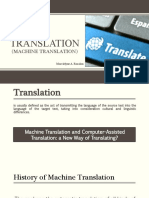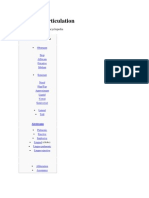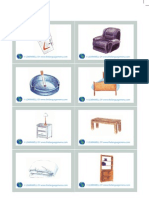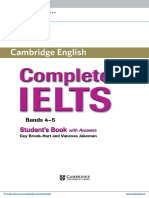Lecture II
Lecture II
Uploaded by
Nguyễn HóaCopyright:
Available Formats
Lecture II
Lecture II
Uploaded by
Nguyễn HóaOriginal Description:
Copyright
Available Formats
Share this document
Did you find this document useful?
Is this content inappropriate?
Copyright:
Available Formats
Lecture II
Lecture II
Uploaded by
Nguyễn HóaCopyright:
Available Formats
Theory of Translation
Lecture II
The second half of the 20th century has seen the in-depth study of translation, which is
sometimes called Theory of Translation, Science of Translation, Translation Linguistics,
or Translatology.
In the West, translation studies began in 1972 with Holmes’s paper presented at the Third
International Congress of Applied Linguistics, “The Name and Nature of Translation
Studies”.
Achievements of the Russian school of translation studies. Works by V. Komissarov, A.
Shveitser, A. Fedorov and many others confirmed the status of translation studies as a
discipline of its own even in the 1950s.
The main concern of translation theory is to determine appropriate translation methods
for the widest possible range of texts and to give insight into the translation process, into
the relations between thought and language, culture and speech.
There are several aspects of this branch of linguistics:
• General theory of translation, whose object is general notions typical of translation
from any language.
• Specific (or partial, in terms of Holmes) theory of translation that deals with the
regularities of translation characteristic of particular languages - for example,
translation from English into Russian and vice versa.
• Special (partial) theory of translation that pays attention to texts of various registers
and genres.
• The process of translation is a set of interlanguage transformations; it is transforming
the text written in one language into the text in another.
ASPECTS
a) historical aspects: oral vs. written vs. Mechanical significance /
historical role of TR - contribution to & impact on:
• development an growth of human culture (trade, preachers, military exchanges,
diplomatic affairs, transfer of artefacts)
• civilisation
• individual languages
b) TYPES: literary vs. non-literary
c) METHODS of ORAL TR: simultaneous vs. consecutive
d) FORM: oral (always non-literary) vs. written
e) medium in which TR is performed:
mechanical & computer-aided vs. Human
Machine translation
The first idea of machine translation is known to have been expressed in 1933 by the Soviet
engineer Petr Smirnov-Troyansky but it is not he but Warren Weaver who is credited as
the founding father of Machine Translation (MT) research.
The first demonstration of an MT system took place in 1954 in Georgetown University,
U.S.A., where the experiment of making a computer translate words from Russian into
English was conducted.
Today, machine translation is often called computer-aided translation (CAT). CAT
systems are divided into two groups: machine-aided human translation (MAHT) and
human-aided machine translation (HAMT). The difference between the two lies in the
roles of computer and human translator.
Machine translation
• a procedure whereby a computer program analyses a source text and produces a
target text without further human intervention.
• however, machine translation typically does involve human intervention, in the
form of pre-editing and post-editing
• an exception to that rule:
➢ e.g., the translation of technical specifications (strings of technical terms e.g.,
the translation of technical specifications (strings of technical terms and
adjectives), using a dictionary-based machine-translation system.
➢ In regard to texts (e.g., weather reportsIn regard to texts (e.g., weather reports)
with limited ranges of vocabularyIn regard to texts (e.g., weather reports) with
limited ranges of vocabulary and simple sentenceIn regard to texts (e.g.,
weather reports) with limited ranges of vocabulary and simple sentence
structure, machine translation can deliver results that do not require much
human intervention to be useful.
The first idea of machine translation is known to have been expressed in 1933 by the Soviet
engineer Petr Smirnov-Troyansky but it is not he but Warren Weaver who is credited as
the founding father of Machine Translation (MT) research.
The first demonstration of an MT system took place in 1954 in Georgetown University,
U.S.A., where the experiment of making a computer translate words from Russian into
English was conducted.
Today, machine translation is often called computer-aided translation (CAT). CAT
systems are divided into two groups: machine-aided human translation (MAHT) and
human-aided machine translation (HAMT). The difference between the two lies in the
roles of computer and human translator.
• a procedure whereby a computer program analyses a source text and produces a
target text without further human intervention.
• however, machine translation typically does involve human intervention, in the
form of pre-editing and post-editing.
Computer-assisted translation
• Computer-assisted translation (CAT), also called computer-aided translation or
machine-aided human translation (MAHT), is a form of translation wherein a
human translator creates a target text with the assistance of a computer program.
The machine supports a human translator.
• Computer-assisted translation can include standard dictionaryComputer-assisted
translation can include standard dictionary and grammar software. The term,
however, normally refers to a range of specialized programs available to the
translator, including translation-memoryComputer-assisted translation can
include standard dictionary and grammar software. The term, however, normally
refers to a range of specialized programs available to the translator, including
translation-memory, terminology-managementComputer-assisted translation can
include standard dictionary and grammar software. The term, however, normally
refers to a range of specialized programs available to the translator, including
translation-memory, terminology-management, concordance, and alignment
programs.
• Computers are used in many aspects of modern translation (particularly of
technical texts).
You might also like
- TB Pro b12Document112 pagesTB Pro b12Emmanuel Jimenez100% (2)
- 2000 Most Common German Words I - Lingo Mastery - 1 PDFDocument8 pages2000 Most Common German Words I - Lingo Mastery - 1 PDFabas00314% (7)
- Interlingual Machine TranslationDocument27 pagesInterlingual Machine TranslationEssam KassabNo ratings yet
- Typesof TRDocument57 pagesTypesof TRAdel BOULKHESSAIMNo ratings yet
- TIpos de TraduccionesDocument55 pagesTIpos de TraduccionesIngles DSNo ratings yet
- Machine Translation Approaches Issues AnDocument7 pagesMachine Translation Approaches Issues AnsevenfoldergirlNo ratings yet
- Machine TranslationDocument22 pagesMachine Translationnigel989No ratings yet
- Instroduction To Machine TranslationDocument15 pagesInstroduction To Machine TranslationdecentdawoodNo ratings yet
- Computer-Assisted Translation ToolsDocument1 pageComputer-Assisted Translation ToolsDenisa NeagoeNo ratings yet
- The Effectiveness of Machine Translation 2uedqkvfr1Document16 pagesThe Effectiveness of Machine Translation 2uedqkvfr1Ha Phuong AnhNo ratings yet
- Machine Translation and Human Translation: in Competition or in Complementation?Document10 pagesMachine Translation and Human Translation: in Competition or in Complementation?lukasinski23No ratings yet
- ITS 07 Presentation KingaDocument13 pagesITS 07 Presentation KingaemailmynameNo ratings yet
- Machine Translation ProjectDocument9 pagesMachine Translation ProjectOffice Hydro-CarpatiNo ratings yet
- Lecture 13 Translation and Terminology Lecture NotesDocument4 pagesLecture 13 Translation and Terminology Lecture NotesIuLy IuLyNo ratings yet
- A Review of Literature of Computer-Assisted Translation: September 2018Document21 pagesA Review of Literature of Computer-Assisted Translation: September 2018GizliustaNo ratings yet
- TSP Reading BrickDocument88 pagesTSP Reading BrickAlifya SyaffaNo ratings yet
- Lecture 11 Аударма Оқытуда Инновациялық ТехнологияларDocument4 pagesLecture 11 Аударма Оқытуда Инновациялық ТехнологияларBonu IrismatovaNo ratings yet
- Encoder Decoder ModelsDocument31 pagesEncoder Decoder ModelsbelwalkarvaradNo ratings yet
- Machine Translation DissertationDocument6 pagesMachine Translation DissertationPayToWriteAPaperCanada100% (1)
- Qun & Xiaojun 2023Document17 pagesQun & Xiaojun 2023pashaiiiiNo ratings yet
- Lingua e Traduzione Inglese 1 - Da StampareDocument52 pagesLingua e Traduzione Inglese 1 - Da Stamparevilumi.mNo ratings yet
- Translation TheoryDocument39 pagesTranslation Theorymahi100% (1)
- Connect 4Document3 pagesConnect 4Amirreza DadipoorNo ratings yet
- JSeva-ODEP-PhD - PristupniRad - Automatic Language TranslationDocument13 pagesJSeva-ODEP-PhD - PristupniRad - Automatic Language TranslationdeakkonNo ratings yet
- Trends in Linguistics: Studies and Monographs 11Document280 pagesTrends in Linguistics: Studies and Monographs 11Mouad BusnsNo ratings yet
- Machine Translation ToolsDocument20 pagesMachine Translation ToolsReminiiNo ratings yet
- Tech 1st OneDocument54 pagesTech 1st Onefosesi6003No ratings yet
- TRANSLATION TheoriesDocument11 pagesTRANSLATION TheoriesBea Nicole AguilanNo ratings yet
- Its - An Interactive Translation SystemDocument9 pagesIts - An Interactive Translation SystemMohammad AlanaziNo ratings yet
- Machine Translation Mondal 2023Document90 pagesMachine Translation Mondal 2023Silvia Saporta TarazonaNo ratings yet
- Machine Translation Abdulla HomiedanDocument19 pagesMachine Translation Abdulla HomiedanMuhammed Ali NarippattaNo ratings yet
- Theory and Methods of Translation (Applied Linguistics, 3 Year Students)Document5 pagesTheory and Methods of Translation (Applied Linguistics, 3 Year Students)Виктория ЕкимоваNo ratings yet
- General Introduction - and Brief HistoryDocument9 pagesGeneral Introduction - and Brief Historyprativa royNo ratings yet
- 3-Article Text-14-1-10-20210215Document21 pages3-Article Text-14-1-10-20210215api-710819219No ratings yet
- End-to-End Evaluation in Simultaneous TranslationDocument9 pagesEnd-to-End Evaluation in Simultaneous TranslationMarco TrujilloNo ratings yet
- Machine Translation Thesis PDFDocument8 pagesMachine Translation Thesis PDFlaurajohnsonphoenix100% (2)
- IntrotocomplingDocument13 pagesIntrotocomplingJaven BNo ratings yet
- Machine Translation Computer-Assisted TranslationDocument33 pagesMachine Translation Computer-Assisted TranslationMaryna DorotiukNo ratings yet
- INTRODUCTION TO TERMINOLOGY AND TRANSLATION COMPETENCE-Part 1Document22 pagesINTRODUCTION TO TERMINOLOGY AND TRANSLATION COMPETENCE-Part 1Denílson100% (1)
- Kompüter Tərcümə ProqramlariDocument65 pagesKompüter Tərcümə Proqramlariİdenty SecuryNo ratings yet
- Resenhas: Performative Linguistics: Speaking and Translating As Doing Things With Words Offers A ConverDocument4 pagesResenhas: Performative Linguistics: Speaking and Translating As Doing Things With Words Offers A Convergabitz88No ratings yet
- Terminology Extraction, Translation ToolsDocument5 pagesTerminology Extraction, Translation ToolsCornelia FeraruNo ratings yet
- E TranslationDocument49 pagesE Translationjaz bazNo ratings yet
- Technology Era in Literary TranslationDocument5 pagesTechnology Era in Literary TranslationIldikó Olasz100% (1)
- Kami Export TC3 2013 Reinke - StudentDocument22 pagesKami Export TC3 2013 Reinke - StudentTabby CatNo ratings yet
- Research Paper (NLP)Document14 pagesResearch Paper (NLP)ASHU KumarNo ratings yet
- Dragsted, Barbara (2006) Computer Aided Ranslation As A Distributed Cognitive TaskDocument22 pagesDragsted, Barbara (2006) Computer Aided Ranslation As A Distributed Cognitive TaskInmaculada Vicente LópezNo ratings yet
- Natural-Language UnderstandingDocument5 pagesNatural-Language Understandingnigel989No ratings yet
- Course Paper On Machine TranslationDocument76 pagesCourse Paper On Machine Translationrebejatatiana100% (2)
- Topic 1 - Translation and TSDocument26 pagesTopic 1 - Translation and TSMila Ani RustyNo ratings yet
- The Statistical Machine TranslationDocument9 pagesThe Statistical Machine TranslationЯна ЗаєцьNo ratings yet
- Routledge Encyclopedia of Translation Studies 2nd Ed. by Mona Baker Gabriela SaldanhaDocument6 pagesRoutledge Encyclopedia of Translation Studies 2nd Ed. by Mona Baker Gabriela Saldanhamaglit777No ratings yet
- Anul III Stit Teoria Traducerii Oct 2016Document43 pagesAnul III Stit Teoria Traducerii Oct 2016Monica Dobre100% (1)
- Dialnet LynneBowkerComputerAidedTranslationTechnology 4925608 PDFDocument4 pagesDialnet LynneBowkerComputerAidedTranslationTechnology 4925608 PDFfouziNo ratings yet
- Automation of Translation Past, Presence, and FutureDocument9 pagesAutomation of Translation Past, Presence, and FutureRadosław JordanowNo ratings yet
- 2015 An Evaluative Study of Machine Translation in The EFLDocument6 pages2015 An Evaluative Study of Machine Translation in The EFLRoberto CalderonNo ratings yet
- Informatics 06 00041 PDFDocument29 pagesInformatics 06 00041 PDFTeacher Lily MaríaNo ratings yet
- List of Terms Used in Translation TechnologiesDocument2 pagesList of Terms Used in Translation TechnologiesnicoletomyshchNo ratings yet
- Eng Assignment v1Document3 pagesEng Assignment v1Talat SaeedNo ratings yet
- Article Kell Our e VuDocument15 pagesArticle Kell Our e VuTú Đặng ĐìnhNo ratings yet
- Difference Between Beneath and UnderDocument2 pagesDifference Between Beneath and UnderNguyễn HóaNo ratings yet
- 29.translation TheoryandPracticeDocument161 pages29.translation TheoryandPracticeNguyễn HóaNo ratings yet
- J.R.Firth's, Dell Hymes', M.A.K Halliday's Model of ContextDocument7 pagesJ.R.Firth's, Dell Hymes', M.A.K Halliday's Model of ContextNguyễn Hóa100% (1)
- Context of SituationDocument92 pagesContext of SituationNguyễn HóaNo ratings yet
- Catford Proposed Four Types of TranslationDocument1 pageCatford Proposed Four Types of TranslationNguyễn HóaNo ratings yet
- Manner of ArticulationDocument6 pagesManner of ArticulationDian Hadi NurrohimNo ratings yet
- Communication Skills Guide PDFDocument62 pagesCommunication Skills Guide PDFFriti Friti100% (1)
- Rpt-Sow Form 1 2024Document7 pagesRpt-Sow Form 1 2024Ismaiza Dan OsmanNo ratings yet
- 16 English TensesDocument11 pages16 English TensesAziz SidiqNo ratings yet
- Things in The House Picture Flashcards by Learnwell OyDocument9 pagesThings in The House Picture Flashcards by Learnwell OyVeronicaGelfgren100% (2)
- Pidgin and Creole LanguagesDocument3 pagesPidgin and Creole LanguagesShakira EnnNo ratings yet
- ST Assisi Matriculatin School - Time Table and Syllabus I To XIDocument19 pagesST Assisi Matriculatin School - Time Table and Syllabus I To XIAssisi SchoolsNo ratings yet
- Adjectives: Level: BeginnerDocument14 pagesAdjectives: Level: BeginnerEdna Soler PradaNo ratings yet
- Type 0: Real Condition/ Real Present/ True Condition/ General TruthDocument7 pagesType 0: Real Condition/ Real Present/ True Condition/ General TruthjansetNo ratings yet
- Final Exam-EnglishDocument6 pagesFinal Exam-EnglishJane JumawanNo ratings yet
- Manipuri (Code: 011) Class - Ix 201 8-19Document2 pagesManipuri (Code: 011) Class - Ix 201 8-19Sarang ThakareNo ratings yet
- Worksheet 3-1Document23 pagesWorksheet 3-1Zeynep DernekNo ratings yet
- ҚМЖ Eng.Plus 8кл 3-тоқсанDocument63 pagesҚМЖ Eng.Plus 8кл 3-тоқсанNurgul LadyNo ratings yet
- Theory: Simultaneous Interpretation: Morales-Peru 2024Document13 pagesTheory: Simultaneous Interpretation: Morales-Peru 2024FRANK KEVIN TUANAMA CACHIQUENo ratings yet
- Bahasa Inggris Maria Septiana U.K. 22610095Document4 pagesBahasa Inggris Maria Septiana U.K. 22610095Maria Septiana Uto KeninNo ratings yet
- Drăgușin Samira-Eleana - Handout - Stanley Fish - Literature in The Reader - Affective StylisticsDocument3 pagesDrăgușin Samira-Eleana - Handout - Stanley Fish - Literature in The Reader - Affective Stylisticselena dincaNo ratings yet
- 9 - 21 Calendario CV Nivel 1Document13 pages9 - 21 Calendario CV Nivel 1Anthony Chino ChambiNo ratings yet
- Conversation 1: English Basic Course - Ficha: 2151934Document3 pagesConversation 1: English Basic Course - Ficha: 2151934Dayana ViracachaNo ratings yet
- First Language English (Oral Endorsement) : Paper 0500/12 ReadingDocument30 pagesFirst Language English (Oral Endorsement) : Paper 0500/12 ReadingMohammed OmerNo ratings yet
- Key Competences For Lifelong Learning: Literacy Personal, Social and Learning To LearnDocument20 pagesKey Competences For Lifelong Learning: Literacy Personal, Social and Learning To LearnPaulo DiasNo ratings yet
- Criticisms of Conceptual Metaphor TheoryDocument17 pagesCriticisms of Conceptual Metaphor TheoryCristinaOlaruNo ratings yet
- Elang 103 Unit 1Document65 pagesElang 103 Unit 1ANGELICA BUENONo ratings yet
- Alt Key Numeric CodesDocument5 pagesAlt Key Numeric CodesRaduAndreiNo ratings yet
- E-Journal GJHSS (G) Vol 19 Issue 2 PDFDocument77 pagesE-Journal GJHSS (G) Vol 19 Issue 2 PDFAlejandro Martinez ManzanoNo ratings yet
- Flat 203105305 1Document14 pagesFlat 203105305 1Patel ShivamNo ratings yet
- Chapter 7: Kleene's Theorem: Regular Expressions, Finite Automata, Transition Graphs Are All The Same!!Document48 pagesChapter 7: Kleene's Theorem: Regular Expressions, Finite Automata, Transition Graphs Are All The Same!!Farrukh SidhuNo ratings yet
- Frontmatter PDFDocument7 pagesFrontmatter PDFAmir Sarabadani0% (3)





























































































